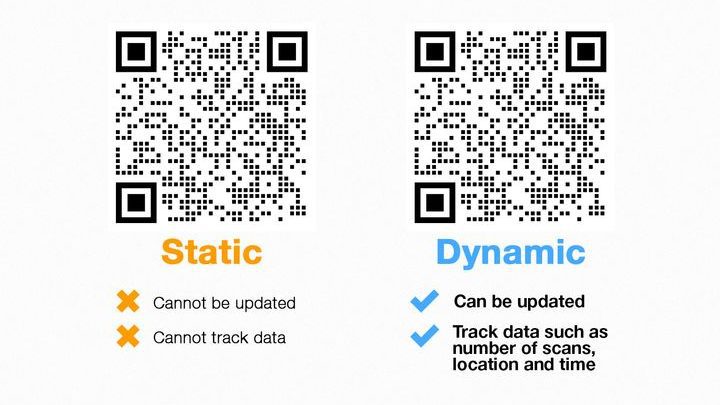Have you heard of a dynamic QR code? It’s like a regular QR code, but with a kick! Dynamic QR codes can be altered even after they’ve been printed, making them a powerhouse in the world of barcode technology. Here’s what you need to know:
Overall, dynamic QR codes are a powerful tool that can enhance any business’s communication with customers. Unleash the potential of your brand with dynamic QR codes today!
Understanding QR Codes: A Quick Refresher
QR code or Quick Response code is a two-dimensional barcode that is capable of storing a significant amount of data, including text, URLs, images, and more. These codes are widely used in marketing, advertising, and other industries to initiate actions and provide customers with a seamless experience.
QR codes can be easily scanned using a smartphone camera or QR code reader app, making them a popular tool for businesses looking to reach their target audience. With that said, QR codes come in two flavors: static QR codes and dynamic QR codes.
What are Dynamic QR Codes?
Dynamic QR codes are similar to static QR codes, but with an important difference – dynamic codes can be edited, tracked, and managed even after they are printed. The information stored in dynamic QR codes is not hardcoded, giving businesses the flexibility to change content as needed, based on feedback or updates to promotions.
With dynamic QR codes, businesses can send users to different landing pages depending on their location, date, time of day, or other factors. This level of personalization is a game-changing accomplishment for brands seeking to streamline their marketing campaigns effectively.
How Dynamic QR Codes Differ from Static QR Codes
Static QR codes are created once and remain static. Once generated, you have to reprint them anytime you want to change the content or sales message advertised by the QR code. Unlike static QR codes, dynamic QR codes can be edited even after you’ve generated them. With dynamic QR codes, you can track leads and adapt your marketing strategy as the need arises.
Another significant difference is that static QR codes don’t provide robust analytical data. Dynamic QR codes, however, can provide businesses with insightful analytical data and information regarding traffic statistics and user behavior.
Advantages of Dynamic QR Codes for Businesses
Dynamic QR codes offer many advantages for businesses of all sizes, including:
- Flexibility – the ability to change the code’s content without reprinting allows businesses to adapt their campaigns quickly and respond to updates in real-time.
- Personalization – Dynamic QR codes can send users to different landing pages based on their location, interests, or preferences. This personalization can significantly improve the customer experience.
- Analytics – Dynamic QR codes can provide businesses with valuable data insights into their customers’ behavior, the number of scans, and the interaction of those customers with the code.
- Cost-effective – a single dynamic QR code can potentially reach millions of users, making it significantly more cost-effective than other marketing channels.
How to Create Dynamic QR Codes
Creating dynamic QR codes might seem to be a daunting task, but it is a straightforward process. A variety of QR code generators, such as QR-Code-Generator.com and QRCode Monkey, offer dynamic capabilities so that businesses can customize their QR codes according to their unique needs.
To create a dynamic QR code, follow these steps:
- Sign up for an account on one of the QR code generators that offers dynamic QR code generation capabilities.
- Create a QR code using a dynamic template and input the relevant information such as URLs or messages you would like your customers to see.
- Customize its appearance using the built-in editor to include your brand’s colors or logos.
- Generate the dynamic QR code!
Best Practices for Using Dynamic QR Codes
While dynamic QR codes possess significant advantages, businesses still need to employ best practices to ensure their campaigns’ success. Here are a few things to keep in mind:
- Test the code: Before printing your dynamic QR code, test it on multiple phones to make sure it works on different devices.
- Provide value to the user: Make sure you provide valuable information to the user after they scan the QR code. Provide them with a discount code, interesting content, or an exclusive offer to encourage then to scan the code in the future.
- Evaluate your results: Use the analytical tools provided with dynamic QR code generators to monitor user interaction with your marketing campaign, providing insight into customer experience, needs, and preferences.
- Show the QR code at the right place:The best place to display QR codes depends on their use. For example, promoting a sales campaign may mean that the QR code is located at the storefront or checkout counter of the store.
Dynamic QR Code Case Studies: Real-Life Examples of Success
Many companies have adopted dynamic QR codes in their marketing strategies with great success. Here are a few examples:
- Dominos Pizza: The pizza company created a dynamic QR code campaign that allowed customers to order their pizza right from Facebook, significantly increasing the company’s conversion rate.
- Mars Internet: The company used dynamic QR codes on a print ad to direct users to an online game, increasing website traffic and user engagement dramatically.
- Siemens: The company deployed dynamic QR codes in elevators to allow users to access real-time data on display panels, providing a better customer experience.
In summary, dynamic QR codes offer an unprecedented amount of flexibility, customization, and insights. By using these codes in creative ways, businesses can effectively increase engagement, drive traffic, and convert casual browsers into loyal customers.





